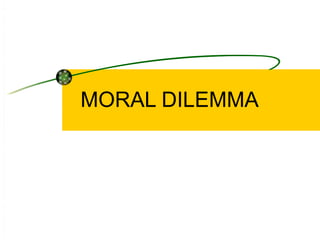
2. moral dilemma.pptx
- 2. The Heinz Dilemma A woman has a rare form of cancer. There is a drug that might save her. The drug costs $4,000 per dose. The sick woman’s husband, Heinz, went to everyone he knew to borrow money and tried every legal means, but he could only get together about $2000.He asked the doctor scientist who discovered the drug for a discount or to let him pay later. The doctor refused.
- 3. Should Heinz break into the laboratory steal the drug for his wife? Why or why not?
- 4. Scenario 2 Heinz broke into the laboratory and stole the drug. The next day the newspapers reported the break in and theft. Brown, a police officer and friend of Heinz remembered seeing Heinz last evening, behaving suspiciously near the laboratory. Later that night, he saw Heinz running away from the laboratory.
- 5. Should Brown report what he saw? Why or why not?
- 6. Scenario 3 Brown reported what he saw. Heinz was arrested and brought to court. If convicted, he faces up to two years’ in jail. Heinz was found guilty.
- 7. Should the judge sentence Heinz to prison? Why or why not?
- 8. Kohlberg Lawrence Kohlberg (1927-87) was a well know theorist in the field of moral development. Of his moral dilemmas the most famous is Heinz’s Dilemma asking questions to probe a person reasoning and specific course of action.
- 9. Kohberg’s Stages of Moral Reasoning Level one – Pre Conventional Morality – Stage 1. Punishment / Obedience Orientation – Stage 2. I Instrumental Relativist Orientation Henry J. Nicols internationalcenterfortalentdevelopment.com Used with permission
- 10. Level two – Conventional Morality Stage 3. Good Boy – Nice Girl Orientation Stage 4. Law and Order Orientation Henry J. Nicols internationalcenterfortalentdevelopment.com Used with permission Kohberg’s Stages of Moral Reasoning
- 11. Level three – Post - Conventional Morality Stage 5. Social Contract Orientation Stage 6. Universal Ethical Principle Orientation Henry J. Nicols internationalcenterfortalentdevelopment.com Used with permission Kohberg’s Stages of Moral Reasoning
- 12. Stage Theory – Everyone goes through stages sequentially without skipping any stage – There is not automatic movement Movement occurs with cognitive dissonance when a person notices inadequacies in their present coping strategy Kohberg’s Stages of Moral Reasoning
- 13. So a person can only understand the stage above their present stage Cognitive dissonance can be created by identifying the inadequacies of the current stage of reasoning. Kohberg’s Stages of Moral Reasoning
- 14. What is a moral dilemma? Lawrence Kohlberg used scenarios that involved ethical decisions. By asking what one would do in this situation, he identified stages of moral development.
- 15. What is a moral dilemma? A useful tool for any discussion on an ethical topic or decision. Requires students to probe and extend thought and discussion regarding any ethical issue presented in the classroom.
- 16. Rationale for exploring principles As teachers, we attempt to instill a range of values into our students. As William R. Rogers so eloquently put it,”values give us our foundation and frame of reference, so we can deal with the world around us”.
- 17. In their formative years, many of students are just beginning to understand their value systems and moral principles. Much of what they believe has been given from their parents, and they are just beginning to move into what Kohlberg describes as the Concern for Acceptance stage, where individuals become extremely sensitive to the expectations and approval of their peers. Rationale for exploring principles
- 18. We cannot separate our values from our experiences. However, these values must be open to change as we face new situations that call for evaluations of new courses of action. It is this "moral struggle" of the opposing views where much of our principles are put to the test, not the pure statements of fact that we all too often are fond of presenting. Rationale for exploring principles
- 19. Characteristics of a moral dilemma • Open-ended approach: - There is no single "right answer." The goal is not to reach agreement but to critically discuss the reasons used to justify a recommended action. The emphasis is on why some reasons may be more appropriate than others.
- 20. Characteristics of a moral dilemma • Free exchange of ideas: - Students should feel comfortable in expressing their thoughts. Each student should have an opportunity to contribute to the discussion within a nonjudgmental atmosphere.
- 21. Characteristics of a moral dilemma • Student to student interaction: - The conversation is primarily between student and student, not teacher and student. The teacher uses questions to guide the discussion and to encourage students at adjacent stages of moral reasoning to challenge one another. Lecture or recitation should be avoided.
- 22. Characteristics of a moral dilemma • Development of listening and verbal skills: - Each student should be intimately engaged in the discussion activity, building and expanding on one another's ideas as well as examining each response critically.
- 23. Characteristics of a moral dilemma • Focus on reasoning: - Reasons are to emphasize the prescriptive “should” rather than the “would arguments.
- 24. Characteristics of a moral dilemma • Dilemmas produce conflict: - Conflict heightens student involvement and interest and should have a personalized meaning for the student. Resolution of internal conflict is a precondition for advancement to higher stage reasoning.
- 25. Instructional Nurturant Moral Dilemmas Empathy Openness to alternatives Sensitivity to Cause- Effect Relationships Examination of consequences Critical listening Identifying issues
- 26. Moral Dilemma 1. Present the Dilemma Story, current event, movie, scientific dilemma, school, family or classroom issue 2. Ask focusing question 3. Generate positions 4. Group students by positions 5. Present positions’ compelling arguments 6. Allow limited clarifying questions or comments 7. Allow position change 8. Present defensible scenario based on
- 27. Where do dilemmas come from - Current events - Literature - Content areas - Classroom issues